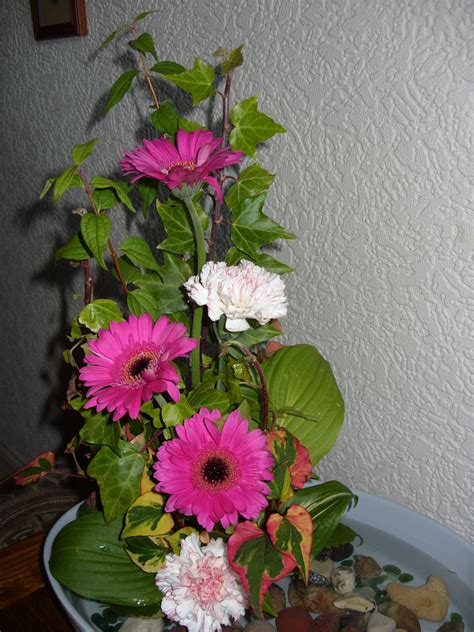Everybody likes flowers, remarkable ability to brighten up a room or the outside of your house is second to none. When it comes to arranging flowers you might be happy with just bunching a number of different types together in a vase and leaving it at that, but you could have a much more impressive display. All that you need is a touch of imagination and creative thinking. Arranging flowers isn't a difficult task, try out the tips below for some impressive results.
Form of Arrangement
You may be surprised to discover that there are a number of different standard forms of flower arrangement, these are:
Vertical arrangement: As the name suggests these are tall, slender arrangements. If you've got a number of long focal flowers you wish to show off utilize this arrangement.Make use of a tall container to put your flowers in, it only needs to be wide enough to use only a small number of surrounding flowers.
Horizontal arrangement: broad and low arrangement, good for a large table design.A traditional horizontal arrangement is symmetrical in form and the placement of flowers. The width needs to be two times the height.The container needs to be shallow and broad, the focal flower(s) in the middle and line flowers inserted almost horizontally.
Triangular arrangement: quite possibly the most common kind of arrangement.The line flowers are first positioned to form a triangle, the triangle ought to always be taller than it is wide.
Oval arrangement: a great arrangement for a formal setting or a living room.The oval arrangement is quite straightforward and ideal for showcasing 1-3 large or medium sized flowers. Choose a short and wide container for this kind of arrangement.Use the line flowers to create the height and shape of the arrangement and place the focal flowers at the centre and fill the gaps with smaller blooms.The arrangement is not intended to be looked at from three hundred sixty degrees.
Minimal arrangement: this kind of flower arrangement usually consists of only a few flowers in a smallish container. Minimal flower arrangements are able to look elegant and understated. Selecting the vase for a minimal arrangement is a lot more important than it is for other types - pick something small but stylish.
Hogarth's Curve: challenging "S" shape which usually demands some skill to get right. Fundamentally the Lazy "S" is a minimal flower arrangement based on the "S" curve. The line flowers make the S shape (much easier if branches are used) and other flowers fill the centre.
Crescent arrangement: the crescent flower arrangement is somewhat more difficult when compared to some of the other arrangements though works excellent as a small table decoration. An asymmetrical arrangement the crescent needs to be well balanced, not only aesthetically nut also physically so it does not fall over. It is probable that you will also require a number of leaves or branches to form the crescent. In order to keep the arrangement secure it is best to use a wide, low container/vase.
Pick a Colouring Scheme
Would you like a dark, calming green/lilac/blue arrangement or a more lively red/orange/yellow one? Colours are possibly the most important factor when selecting your flowers.Understanding basic colour theory can be very helpful here - there are numerous guides on the net. Some common blends include: Analogous colours - these are colours which are adjacent to one another on the colour wheel like orange, yellow and green; or you could try complementary colours - colours from opposite sides of the colour wheel; or triads - 3 colours equally space around the colour wheel. Another alternative of course is to apply a less academic method and just decide on colours that you simply find appealing.Keep in mind colours can often express a number of feelings like love, sympathy, friendship, happiness etc. Choose the right colours for the sentiments you are trying to convey.
Selecting Appropriate Flowers
With so many types this can seem like a overwhelming task initially however we are able to break them down into three different types:
Line flowers - taller flowers which determine the shape, height and width of the arrangement, they usually have flowers or buds along their stem.Common line flowers are snapdragons, gladiolus, curly willow, delphinium, tuberose and bells-of-Ireland.
Mass flowers - big round flowers on a single stem, they are the main focal point of the arrangement.Typical mass flowers (also called focal flowers) include daisies, magnolias, roses, daffodils, carnations, tulips, sunflowers, iris and lilies.Mass flowers are sold in bunches, you should place these in the middle of your arrangement.
Filler flowers - filler flowers consist of stems with plenty of little blooms and leaves, these fill the gaps and give a visible link between the line and focal flowers.Good examples of these are: ferns, aster, baby's breath, feverfew, Queen Anne's lace, heather, eucalyptus.
When selecting the flowers also think about the following factors:
Seasonal flowers - blooms that are in season are usually much better value compared to flowers which aren't owing to the simple fact that flower growers have got so many of them
Flower meanings - Floriography (language of flowers) - just as with colours, since Victorian times a number of flowers have had certain meanings/symbolism.
Forget the rules - there are a great number of guides and articles written on mixing colours and flowers and along with them many rules. If the rules state that they should never go together but you feel they should, put them together - you are probably right.












Post Title
→Arranging Flowers
Post URL
→http://structure-flower.blogspot.com/2018/05/arranging-flowers.html
Visit Structure Flower
0 comments:
Post a Comment